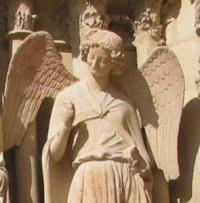
France Revisited pays homage to that great Gothic monument at the center of the capital and to four other Gothic Notre-Dame Cathedrals within 100 miles of Paris in a two-part article. Part II below concerns Notre-Dames of Reims and Amiens and includes practical tips for visiting all five. Part I concerns Notre-Dames of Paris, Laon and Chartres.
* * *
Notre-Dame de Reims
The Gothic cathedrals of Europe were very much the skyscrapers of their time both for their reach to the sky and their intent to demonstrate the stature of the cities and of the bishoprics (a Roman Catholic cathedral refers to the church that is the seat of the bishop) in which they were built.
In 469 Clovis, King of the Franks, was baptized in Reims by Bishop-cum-Saint Remi. That fundamental consecration of the marriage of Church and King in France, is shown on the façade of Notre-Dame de Reims as it is in many other cathedrals in France. (The marriage was formally dissolved during the French Revolution. There were attempts at national therapy to patch things up in the 19th century, but for over a hundred years now the marriage has been declared over, with the separation of assets clearly identified by the law of 1905.)
In memory of the baptism of Clovis, it became firm tradition as of the 9th century that a king of France should come to Reims, 80 miles northeast of Paris, to confirm his divinely-inspired power over his kingdom and the Church’s intimate role in that power. That confirmation required anointing by a holy ointment kept in a holy vial. By the time this Notre-Dame was begun, in 1211, the construction of a cathedral in keeping with Reims’s stature and role as the site of royal unction was long overdue.
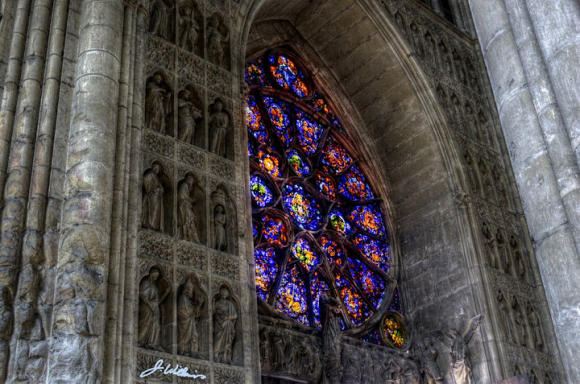
Since the coronation of Louis VIII in 1223, all but three of the French kings were crowned in this cathedral. Those three are: Louis VI, who received unction in Orleans in 1108 because he felt it would be dangers to travel to Reims; Henri IV, who was crowned in Chartres in 1594 because Reims was in the hand of his enemies; Louis XVIII, who returned from exile in England to become king in 1814 and for whom no coronation ceremony was held in France.)
The historical events surrounding the 1429 coronation of Charles VII in the presence of Joan of Arc, who’d heard voices telling her that that the king must quit cowering in the Loire Valley and assume his god-given role in France, is celebrated each year in Reims over the first weekend of June in an annual Joan festival called les Fêtes Johanniques. The major event of the weekend is the Sunday afternoon reenactment of the procession to the cathedral from Saint Remi Basilica, Reims’ other important and impressive architectural monument.

Visitors arriving by car will find that the frontal approach leading to Rue Rockefeller and then the vast square in front of the cathedral is regal indeed. American industrialist John D. Rockefeller got the honors of a street named after him in thanks for the enormous funding he provided in the 1920s to rebuild the cathedral which had been heavily damaged by bombardment during WWI. (Another sizable donation by the American industrialist Andrew Carnegie allowed for the construction of the beautiful Art Deco public library that’s near the cathedral.)
There are lots of 20th-century windows here because of war damage, including the bright blue windows that draws your gaze the far end of the cathedral when you first enter were created by Marc Chagall in 1974.
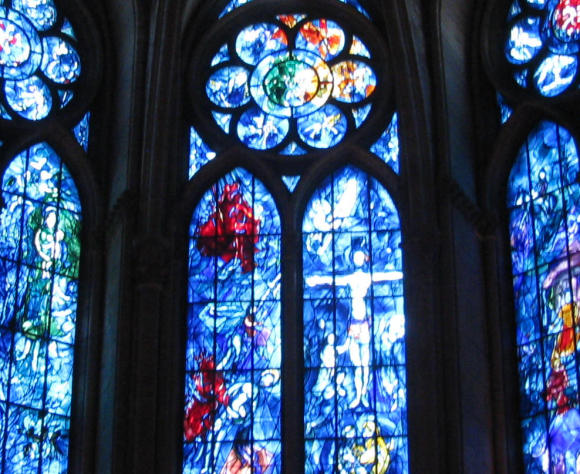
Unlike Chartres, where the cathedral is the destination, Notre-Dame de Reims often plays second fiddle to the town’s main attraction: its champagne houses. After all, Reims along with Epernay, 18 miles south, are the main centers for champagne production, with many small producers nearby along the slopes between the two towns. Millions of bottles lie fermenting in tunnels north and east of the cathedral. Those bottles will eventually see the light of day—or night—dressed in the labels of Taittinger, Pommery, Mumm, Ruinart, Veuve-Cliquot, and other champagne houses.
There’s no escaping the influence of bubbly in Reims, even in the cathedral, where a series of stained glass windows donated by the region’s winemakers show it being made as though a scene from a regional bible.
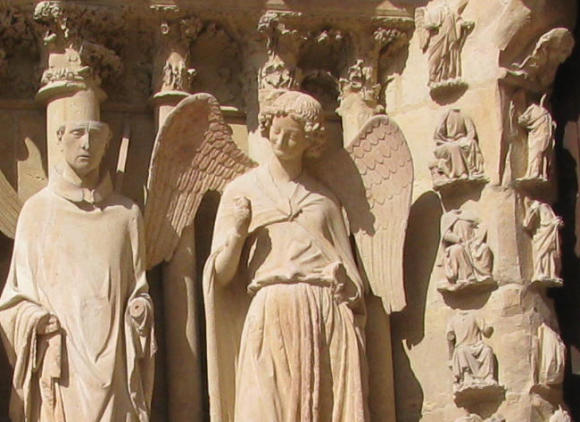
But the most joyful symbol of the marriage of Church and champagne is the smiling angel on the façade of the cathedral that has come to represent the city itself. It wasn’t created with sparkling wine in mind, yet no visitor now admires the angel without associating the two.
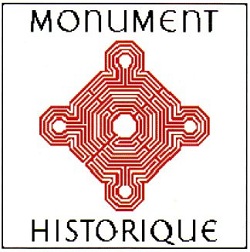 Like Chartres and Amiens, Reims also had a labyrinth on its floor, but it was removed by the Church in 1779. Nevertheless, its image, taken from drawings made when the labyrinth was in place, is now the French Ministry of Culture’s logo designating historical monuments.
Like Chartres and Amiens, Reims also had a labyrinth on its floor, but it was removed by the Church in 1779. Nevertheless, its image, taken from drawings made when the labyrinth was in place, is now the French Ministry of Culture’s logo designating historical monuments.
Notre-Dame d’Amiens
The final spoke in these radiating Notre-Dames leads north to the Cathedral of Amiens, 80 miles north of Paris, which has the largest interior of all the medieval mastodons of France, twice as voluminous as its elder sister Notre-Dame de Paris.
Amiens is perhaps the most harmonious of these cathedrals because, following the destruction of a previous cathedral destroyed by fire in 1218, it was built in a relatively short period of 50 years, from 1220 to 1270, making this the rare cathedral that an individual might see started and consecrated during his lifetime.
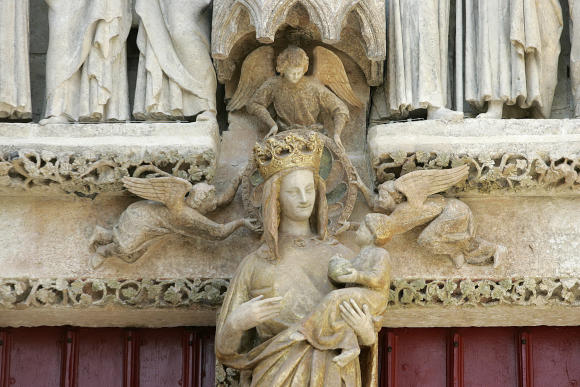
Along with its architectural prowess, the cathedral reveals a treasure chest of biblical, spiritual, political, and local anecdotes in stone, wood, and glass, all in tip-top condition thanks to cleaning and restoration in the 1990s. That work brought to light evidence of the extent to which the sculptures on the facade were painted in the Middle Ages. We often think of these medieval churches as being the color of the naked limestone, but in fact they were highly colored. An impressive 40-minute sound-and-light show (after nightfall in spring and summer and again in December) projects estimates of the original colors on the façade. Reims and Chartres also have sound-and-light shows against the façade of their cathedrals.
For the quality and drama of its sculptural works inside and out, Amiens is a remarkable monument to the talents of 13th century sculptors. Among its most celebrated details are the cartoon-like images of Hell on the central door, the crying angel behind the choir that came to be dear to soldiers visiting during the First World War, and the Golden Virgin which has been brought inside from its original pedestal on the southern entrance, where a copy now stands.
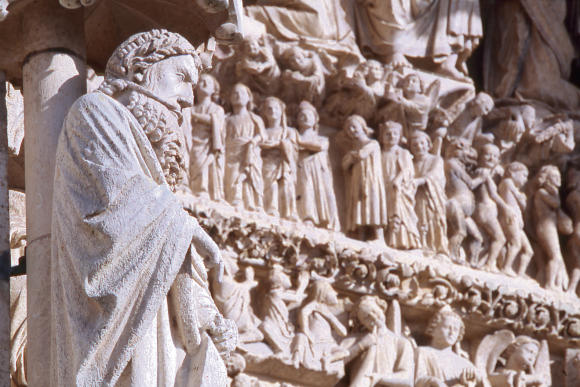
By the time Amiens’ cathedral was underway, the French style of architecture had gone mainstream and was spreading throughout Europe; Gothic cathedrals then sprouted up in surrounding kingdoms and empires until the 15th century. Then new winds of architectural and artistic change, those of the Renaissance, began to blow across the continent, this time set in motion by Italy. Follow those winds on another architectural trip abroad.
Practical information for visiting the five Notre-Dames
The Notre-Dames of Paris, Chartres, Laon, Reims and Amiens are all open daily and free for all visitors. These cathedrals are designated as national monuments; they are property of and largely maintained by the state, with the Catholic Church having permanent use of them for religious purposes. Visitors can enter at all times during the day except in the case of special events. Portions designated for religious service may be cordoned off for those attending service.
Church policy requests modest dress, such as covered shoulders and skirts or shorts that aren’t too short, and men should remove any hats upon entering. But authorities are fairly relaxed about it these days. In any case, visitors should respect the fact that the buildings do have a religious function along with their secular appeal as historical monuments.
If traveling in spring and summer consider attending a sound-and-light show after nightfall at the cathedrals of Chartres, Reims and Amiens (whose show also takes place in December).
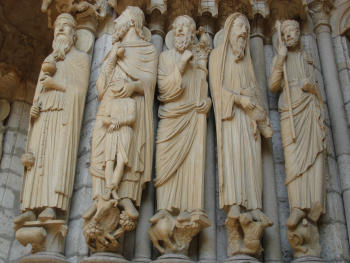
While you can visit any of those outside of Paris by radiating out from the capital, Amiens, Laon (to which can be added the Gothic Saint-Quentin Basilica between Amiens and Laon) and Reims can be visited in a driving tour of the regions north and northeast of Paris. These can be combined with explorations of WWI sites in the countryside, making for a fascinating two or three or four days of historical touring, ending with a glass or three of champagne in and around Reims. The central tourist offices of those towns can provide information about WWI sites (including those with an American and Canadian presence) and specialized tours in the surrounding area.
Paris: The official website of the Paris Convention and Visitors Bureau gives much practical information about visiting the city. The Catholic’s Church’s own information site about Notre-Dame provides details about the edifice as well as mass times, church-organized tours and concerts (the latter include free Sunday afternoon organ concerts which have been suspended during work on the instrument in 2012 and will resume in January 2013). Paris’s other great Gothic structure, the Saint Chapelle (Holy Chapel), the royal chapel of exquisite construction and mostly 13th-century glass, is just a few hundred yards from Notre-Dame in what was formerly a royal palace complex and is now the city’s judicial complex.
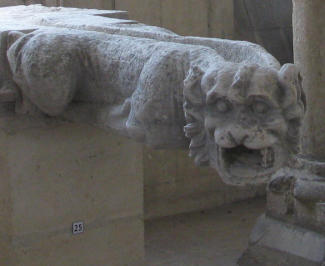
Saint-Denis: Saint-Denis Basilica, which is considered the first major structure built at the start of the Gothic era when reconstruction of its apse began in 1144, is located in the suburb/city of Saint-Denis, just north of Paris, and can be reached on metro (subway) line 13 at station Basilique de Saint-Denis. In 1966 it was also given the status of cathedral, so it is officially called the Basilica-Cathedral of Saint Denis. In addition to presenting extraordinary and luminous architecture, the basilica-cathedral contains dozens of royal tombs and funerary monuments since this was the traditional burial place of the royals of France. There is an entrance fee to visit the tombs and monuments. More information can be found here.
Chartres: 56 miles southwest of Paris; 1¼ hour by car; an hour by train departing from Paris Montparnasse Station; about $21 one way. In addition to its daytrip appeal, Chartres can be visited on the way to/from the Loire Valley or Brittany or as a detour to/from Normandy. Tourist information can be found here. The church’s own website is here. A sound-and-light show takes place on the facade of the cathedral from April 20 to September 21.
Laon: 85 miles northeast of Paris; 2 hours by car; 1½-2 hours for direct trains departing every hour or two from Paris North (Nord) Station; about $30 one way. The Laon Tourist Office is beside the cathedral. Tourist officials have told me that few Canadians or Americans visit the town, so North Americans should stop into the tourist office while here and ask to be counted. Cathedral tours are worthwhile even when only in French because they give access to portions of the building that are otherwise inaccessible. Also see this photo reportage about Notre-Dame de Laon.
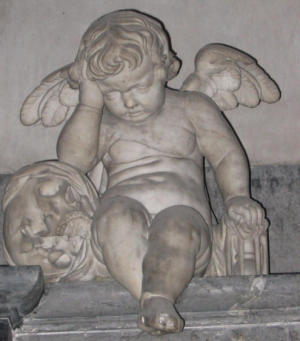
Reims: 80 miles northeast of Paris; 1¾ hours by car; 45-50 minutes by high-speed train (TGV) from Paris East (Est) Station; about $44. The tourist office is next to the cathedral and can provide information about visiting champagne house in the city. The church’s own website is here. A 25-minute sound-and-light show takes place at the cathedral certain evenings from June to September.
Amiens: 80 miles directly north of Paris; 1 ¾ hours by car; 70-100 minutes for direct trains leaving about every 1½ hours from Paris North (Nord) Station; about $29 one way. Amiens’ tourist information website is found here. Amiens projects a magnificent light show onto the façade of its cathedral. The last train back to Paris from Amiens leaves shortly after 8pm most days, though, so in summer you’ll have to miss either the show or the train. The 40-minute projection begins at 7pm during its December run, when Amiens’ Christmas market may add a bit of an attraction, so those willing to venture north at that time of year can catch part of the show before hurrying off to the station. Also see this article about Amiens.
© 2012, Gary Lee Kraut


I would highly recommend the laser light show at Reims Cathedral. It shows you how the Cathedral was constructed and is an amazing spectacle. It it runs during over the Christmas period 23 Nov – 1 Jan.